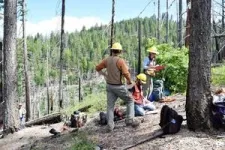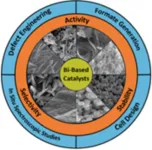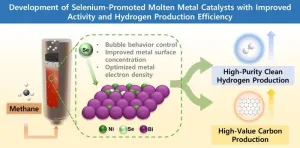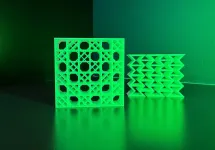(Press-News.org) To develop a practical fusion power system, scientists need to fully understand how the plasma fuel interacts with its surroundings. The plasma is superheated, which means some of the atoms involved can strike the wall of the fusion vessel and become embedded. To keep the system working efficiently, it’s important to know how much fuel might be trapped.
“The less fuel is trapped in the wall, the less radioactive material builds up,” said Shota Abe, a staff research physicist at the U.S. Department of Energy’s (DOE) Princeton Plasma Physics Laboratory (PPPL).
Abe is the lead researcher on a new study published in Nuclear Materials and Energy. The study looks specifically at how much deuterium – thought to be one of the best fuels for fusion – might get stuck in the boron-coated, graphite walls of a doughnut-shaped fusion vessel known as a tokamak. Boron is used in some experimental fusion systems to reduce plasma impurities. However, researchers do not fully understand how a boron coating might impact the amount of fusion fuel that leaves the plasma and becomes embedded in the vessel walls.
“Understanding how boron coatings can interact with deuterium can help us improve materials for future fusion power plants, such as ITER,” said Abe. ITER is the multinational facility under assembly in France, which will study plasma that can heat itself and sustain its own fusion reactions.
In addition to researchers from PPPL, a sizable team of experts from institutions across the country contributed to the new study on fuel retention, including researchers from Princeton University, the University of California-San Diego, General Atomics, the University of Tennessee and Sandia National Laboratories. Their world-leading work is critically important to making fusion a viable source of electricity on a commercial scale.
Deuterium also stands in for tritium in experiments
In a commercial fusion system, the fuel will likely be made of deuterium and tritium, which are both forms of hydrogen. Tritium is radioactive, but deuterium is not. So, the experiments used deuterium as a stand-in for tritium, as they are similar in many respects. But tritium is an element that must be carefully managed in commercial-scale fusion systems.
“There are very strict limitations on how much tritium can be in a device at any given time. If you go above that, then everything stops, and the license is removed,” said Alessandro Bortolon, a managing principal research physicist at PPPL who also contributed to the work. “So, if you want to have a functioning reactor, you need to make sure that your accounting of tritium is accurate. If you go over the limit, that’s a showstopper.”
Interestingly, the researchers say the main cause of the trapped fuel isn’t the boron coating. It’s carbon. Even small amounts of carbon increased the amount of deuterium fuel trapped in the samples during the experiment. These boron film samples were created using a plasma made of a gas containing boron and deuterium (as well as with some impurities) in DIII-D, a tokamak at General Atomics. The carbon and the boron together can bind so tightly to deuterium that it would take temperatures around 1000°F to break the bond, making it very challenging to remove the fuel without damaging the fusion system.
“The carbon is really the troublemaker,” said PPPL Staff Research Physicist Florian Effenberg, who is also a co-author of the paper. “Carbon must be minimized. While we cannot get it to zero, we use all the means we have to reduce the amount of carbon as much as possible.”
In fact, exposure to a plasma with small amounts of carbon contamination increased the amount of deuterium significantly. The researchers found that for every five units of boron trapped in a sample, two units of deuterium were trapped.
Graphite tiles to be swapped out
The DIII-D fusion system was used in the experiments and currently has walls made from graphite, a form of carbon. “We want to get rid of all the carbon and have clean tungsten walls,” said Effenberg, to ensure the calculations are even closer to what will be experienced in ITER.
One of the strengths of the research is that some of the samples were exposed to plasma in the DIII-D fusion vessel. The machine is one of several experimental tokamaks that operate using magnetic fields to hold plasma in a doughnut shape. Given that the research suggests that even trace amounts of carbon can drastically increase the amount of tritium stuck in the walls of a tokamak, the results could have important implications for meeting regulatory limits in future fusion power plants.
Other researchers on the project include Michael Simmonds, Igor Bykov, Jun Ren, Dmitry L. Rudakov, Ryan Hood, Alan Hyatt, Zihan Lin and Tyler Abrams. This research was supported by the DOE’s Office of Fusion Energy Sciences under awards DE-FC02-04ER54698, DE-AC02-09CH11466, DE-SC0022528, DE-SC0022528 and DE-SC0023378.
END
Some fuel lodges in the inner walls of fusion vessels. Researchers now have a better idea of how much.
New research exposing samples to the superheated plasma in DIII-D could help make fusion systems safer and more efficient
2025-02-26
ELSE PRESS RELEASES FROM THIS DATE:
Bismuth-based catalysts: Promising candidates for electrochemical CO2 reduction to formate
2025-02-26
The electrochemical reduction of CO2 has been recognized as a promising strategy to convert ambient atmospheric CO2 into valuable products. Bismuth-based catalysts have garnered the widespread attention of researchers due to their cost-effectiveness, low toxicity, and high natural abundance. Significant progress has been made toward enhancing the reactivity of catalyst structures through innovative synthesis techniques and engineering. Advances include the use of flow cells and membrane electrode assembly (MEA) cells to attain high cathodic current densities of over 200 mA cm-2 with superior ...
Novel molten metal catalysts for CO2-free hydrogen production
2025-02-26
Researchers in South Korea have developed an advanced liquid metal catalyst incorporating selenium (Se) to enhance the efficiency of turquoise hydrogen production.
Turquoise hydrogen is generated via methane (CH₄) pyrolysis, producing hydrogen while yielding solid carbon as a byproduct, without emitting carbon dioxide (CO₂).
A research team led by Dr. Seung Ju Han at the Korea Research Institute of Chemical Technology (KRICT) has introduced selenium-doped molten metal catalysts (NiBi, CuBi) to significantly enhance methane pyrolysis efficiency. The technology demonstrates ...
Beyond the burn: Harvesting dead wood to reduce wildfires and store carbon
2025-02-26
A century of fire suppression, combined with global warming and drought, has led to increasingly destructive wildfires in the Western United States. Forest managers use tools like prescribed burns, thinning, mastication, and piling and burning to reduce fuel – live and dead trees, needles and leaves, and downed branches – that can feed intense wildfires. These methods aim to lower fuel levels, reduce crown density, and protect fire-resistant trees, fostering healthier, more resilient forests.
However, prescribed burning efforts haven’t kept up with the rapid buildup of surface fuel, creating a “fire deficit” – the gap between the amount of fuel that has ...
Researchers at Case Western Reserve, University Hospitals to begin clinical testing with new, less-invasive technology to screen for esophageal precancer
2025-02-26
CLEVELAND—Researchers at Case Western Reserve University (CWRU) and University Hospitals (UH) will use state-of-the-art medical technologies they invented—and licensed to Lucid Diagnostics Inc.—to detect esophageal precancer, specifically Barrett’s Esophagus (BE).
BE is a change in the cellular structure of the esophageal lining typically caused by gastroesophageal reflux disease (GERD), also known as heartburn. The goal is to reduce the incidence of esophageal cancer (EAC).
EAC is a rare type of cancer with a high-morality rate—the cause of 2.6% of all cancer ...
JMC|With generative AI assistance, Insilico Medicine announces novel CDK12/13 dual inhibitors for tumor treatment
2025-02-26
Insilico Medicine ("Insilico"), a clinical stage generative artificial intelligence (AI)-driven biotechnology company, today announced the publication of a novel series of orally available covalent CDK12/13 dual inhibitors, as a potential option against refractory and treatment-resistant cancers. Published in the Journal of Medicinal Chemistry (IF=7.2), the study showcases the discovery of compound 12b, a potent, selective, and safe therapy targeting CDK12/13, empowered by Insilico’s proprietary generative AI platforms including PandaOmics and ...
Novel photochromic glass can store rewritable 3D patterns
2025-02-26
For decades researchers have been exploring how to store data in glass because of its potential to hold information for a long time — eons — without applying power. A special type of glass that changes color in different wavelengths of light, called photochromic glass, holds promise for stable, reusable data storage. Now, researchers have developed a doped photochromic glass that has the potential to store rewritable data indefinitely, according to research published in ACS Energy Letters.
Certain types of ...
Sea sponge inspires super strong compressible material
2025-02-26
Inspired by the humble deep-sea sponge, RMIT University engineers have developed a new material with remarkable compressive strength and stiffness that could improve architectural and product designs.
The double lattice design was inspired by the intricate skeleton of a deep-sea sponge known as Venus' flower basket, which lives in the Pacific Ocean.
Lead author of the latest RMIT study into the structure, Dr Jiaming Ma, said extensive testing and optimisation revealed the pattern's impressive combination of stiffness and strength, mixed with an ability to contract when compressed.
It’s this last aspect – known as auxetic behaviour – ...
AI generates playful, human-like games
2025-02-26
While we are remarkably capable of generating our own goals, beginning with child’s play and continuing into adulthood, we don’t yet have computer models for understanding this human ability.
However, a team of New York University scientists has now created a computer model that can represent and generate human-like goals by learning from how people create games. The work, reported in the journal Nature Machine Intelligence, could lead to AI systems that better understand human intentions and more faithfully model ...
Bacteria ‘leaking across stomach lining’ could indicate risk of gastric cancer, new study has found
2025-02-26
A pioneering study has revealed new insights into the role of gastric bacteria in stomach cancer development that could pave the way for a more effective treatment of pre-cancer according to a study published today in Helicobacter.
The Royal Society and Cancer Research UK-funded research led by Dr Amanda Rossiter-Pearson at the University of Birmingham identified a crucial interaction between Helicobacter pylori and non-H. pylori bacteria in the pre-cancerous stage of gastric cancer.
Gastric cancer is the fourth ...
Feeding anemone: Symbiote fish actively feed hosts in wild
2025-02-26
Anemonefish, sometimes called clownfish, have been popular attractions in aquariums ever since Disney’s animated film Finding Nemo arrived in cinemas in 2003. Living symbiotically with sea anemones that shelter them from predators, the fish drive away organisms that nibble at their hosts. Anemonefish have also shown they will provide their hosts with the food given to them by humans, but does this happen in the wild?
An Osaka Metropolitan University Graduate School of Science team led by PhD student Yuya Kobayashi and Professor Satoshi Awata found evidence of this feeding behavior during field experiments. ...
LAST 30 PRESS RELEASES:
Making lighter work of calculating fluid and heat flow
Normalizing blood sugar can halve heart attack risk
Lowering blood sugar cuts heart attack risk in people with prediabetes
Study links genetic variants to risk of blinding eye disease in premature infants
Non-opioid ‘pain sponge’ therapy halts cartilage degeneration and relieves chronic pain
AI can pick up cultural values by mimicking how kids learn
China’s ecological redlines offer fast track to 30 x 30 global conservation goal
Invisible indoor threats: emerging household contaminants and their growing risks to human health
Adding antibody treatment to chemo boosts outcomes for children with rare cancer
Germline pathogenic variants among women without a history of breast cancer
Tanning beds triple melanoma risk, potentially causing broad DNA damage
Unique bond identified as key to viral infection speed
Indoor tanning makes youthful skin much older on a genetic level
Mouse model sheds new light on the causes and potential solutions to human GI problems linked to muscular dystrophy
The Journal of Nuclear Medicine ahead-of-print tip sheet: December 12, 2025
Smarter tools for peering into the microscopic world
Applications open for funding to conduct research in the Kinsey Institute archives
Global measure underestimates the severity of food insecurity
Child survivors of critical illness are missing out on timely follow up care
Risk-based vs annual breast cancer screening / the WISDOM randomized clinical trial
University of Toronto launches Electric Vehicle Innovation Ontario to accelerate advanced EV technologies and build Canada’s innovation advantage
Early relapse predicts poor outcomes in aggressive blood cancer
American College of Lifestyle Medicine applauds two CMS models aligned with lifestyle medicine practice and reimbursement
Clinical trial finds cannabis use not a barrier to quitting nicotine vaping
Supplemental nutrition assistance program policies and food insecurity
Switching immune cells to “night mode” could limit damage after a heart attack, study suggests
URI-based Global RIghts Project report spotlights continued troubling trends in worldwide inhumane treatment
Neutrophils are less aggressive at night, explaining why nighttime heart attacks cause less damage than daytime events
Menopausal hormone therapy may not pose breast cancer risk for women with BRCA mutations
Mobile health tool may improve quality of life for adolescent and young adult breast cancer survivors
[Press-News.org] Some fuel lodges in the inner walls of fusion vessels. Researchers now have a better idea of how much.New research exposing samples to the superheated plasma in DIII-D could help make fusion systems safer and more efficient









